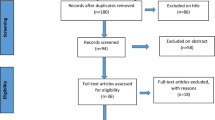Abstract
Background
Although tension-free mesh repair has markedly improved the outcome of inguinal hernia surgery, it has only minimally reduced the incidence of persistent postoperative pain. The pathogenesis of this complication and treatment remain unclear.
Study design
In order to objectively assess whether iliohypogastric neurectomy reduces the incidence and intensity of persistent postoperative pain, we prospectively studied 100 male patients with bilateral inguinal hernia who underwent tension-free surgical repair, combined with iliohypogastric neurectomy on the right side alone. Pain was evaluated postoperatively on days 1 and 7 and at 1 and 2 years by means of a visual analog scale. Patients were given a questionnaire including coded terms for describing pain. These terms were designed to compare pain on the neurectomized and non-neurectomized sides and assess altered sensation (hypoesthesia and paresthesia) on both sides.
Results
There were differences in the incidence and intensity of pain between the neurectomized and non-neurectomized sides, though these differences were not significant. Individual patient assessment showed that from postoperative day 7 onward patients had on average less pain on the neurectomized side.
Pain reduction was more prominent in patients who scored 4 or more on the visual analog scale. No significant difference was found in the incidence of sensory alterations between the two sides. Two years after inguinal hernia repair, only one of the 100 patients studied still had persistent pain (>4 on the visual analog scale); this pain was on the non-neurectomized side.
Conclusions
Our prospective data do not reach statistical significance to claim that iliohypogastric neurectomy reduces the incidence and intensity of persistent postoperative pain after tension-free inguinal hernioplasty. Studies on larger patient samples are warranted to provide definitive, statistically supported conclusions.
Similar content being viewed by others
References
O’Riordan DC, Kingsnorth AN. Audit of patient outcomes after herniorraphy. Surg Clin North Am 1998;78:1129–1139
The EU Hernia Trialist Collaboration. Repair of groin hernia with synthetic mesh. Meta-analysis of randomized controlled trials. Ann Surg 2002;235:322–332
Banna P, Negro P, Trabucchi E. L’ernia inguinale. Arch Atti Soc It Chir 2002;1:15–19
Bassini e nuovo metodo operativo per la cura dell’ernia inguinale. R. Stabilimento Prospendini, Padova, Italy, 1889 [Monografia]
Condon RE. Groin pain hernia repair. Ann Surg 2001;233:8 [editorial]
Lichtenstein IL, Shulman AG, Amid PK, et al. Cause and prevention of postherniorraphy neuralgia: a protocol for treatment. Am J Surg 1988;155:786–790
Bay-Nielsen M, Perkins FM, Kehlet H. Pain and functional impairment 1 year after inguinal herniorraphy: a nationwide questionnaire study. Ann Surg 2001;233:1–7
Wantz GE. Testicular atrophy and chronic residual neuralgia as risk of inguinal hernioplasty. Surg Clin North Am 1993;73:571–581
Pappalardo G, Guadalaxara A, Illomei G, et al. Prevention of postherniorraphy persistent pain: results of a prospective study. Int Surg 1999;84,4:350–453
Courtney CA, Duffy K, Serpell MG, et al. Outcome of patients with severe chronic pain following repair of groin hernia. Br J Surg 2003;90:367–368
Galer BS, Jensen MP. Development and preliminary validation of a pain measure specific to neuropathic pain; the Neuropathic Pain Scale. Neurology 1997;48:332–338
SPSS Base 11.0 for Windows. User’s guide
Zuliani A, Nenna E, Costanzo A. Elementi di statistica inferenziale. Edizioni Kappa. Roma
Lichtenstein IL. Herniorrhaphy—a personal experience with 6321 cases. Am J Surg 1987;153:553–559
The EU Hernia Trialist Collaboration. Mesh compared with non-mesh methods of open groin hernia repair: systematic review of randomized controlled trials. Br J Surg 2000;87:854–859
Condon RE, Nyhus LM. Complications of groin hernia. In Condon RE, Nyhus LM, editors, Hernia, 4th Edition, Philadelphia, J.B. Lippincott, 1995:269–282
Poobalan AS, Bruce J, Smith WC, et al. A review of chronic pain after inguinal herniorraphy. J Pain 2003;19:48–54
Author information
Authors and Affiliations
Corresponding author
Rights and permissions
About this article
Cite this article
Pappalardo, G., Frattaroli, F.M., Mongardini, M. et al. Neurectomy to Prevent Persistent Pain after Inguinal Herniorraphy: A Prospective Study Using Objective Criteria to Assess Pain. World J Surg 31, 1082–1087 (2007). https://doi.org/10.1007/s00268-006-7627-9
Published:
Issue Date:
DOI: https://doi.org/10.1007/s00268-006-7627-9




